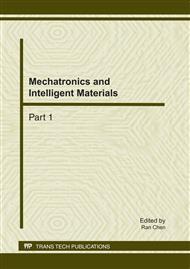p.1
p.6
p.11
p.16
p.21
p.26
p.31
p.36
Analysis of Take-Off Performances for a Double-Joint Hopping Leg
Abstract:
The paper is focused on a double-joint hopping leg driven by motors. Using relative coordinates, its kinematics and dynamics between the system and components are established during the launching stage of jumping, and the take-off mechanism is analyzed. Based on mechanics of jump movement and joint trajectory planning method, the impact of the change of the system initial posture and joint trajectories upon the system take-off performances, such as energy efficiency, instantaneous velocity of the system center of mass (CoM), is discussed by using numerical simulation approach with drive constraints. For a hopping robot, good take-off performances can improve its motion ability, so the resulted conclusions here provides a useful and helpful reference for analyzing and designing a multi-joint hopping robot.
Info:
Periodical:
Pages:
16-20
Citation:
Online since:
February 2011
Authors:
Price:
Сopyright:
© 2011 Trans Tech Publications Ltd. All Rights Reserved
Share:
Citation:



